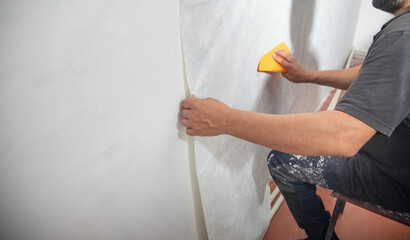Landscaping in Greensboro NC involves the creative design and maintenance of outdoor environments. It includes elements like plant selection and placement, soil improvements, and water management.
Organic mulches such as chopped leaves, straw, wood chips, shredded bark, and compost decompose over time, adding nutrients to the soil. They also help to retain moisture and inhibit weed growth.
Mulching is one of the simplest and most important things you can do to improve your garden and landscape plantings. It reduces erosion, adds nutrients, suppresses weeds and moderates soil temperatures. It also helps retain moisture, which is especially critical in sandy and clay soils. In addition, it protects the plant foliage from the sun’s UV rays and prevents diseases that splash up onto leaves during rain storms.
Organic mulches include grass clippings, straw vetted for the absence of “forever chemicals,” shredded bark, wood chips, or compost. Inorganic materials include gravel, stone, and landscape fabric. Almost anything that can be spread on the soil surface can be used for mulch, but organic and natural (carbon-based) materials are best. They are better for the soil and the environment than plastic or synthetic materials, which don’t break down and can leach toxic compounds into the soil.
To prepare for mulching, the first step is to clear out vegetable and annual flower beds of fallen leaves and debris that clogs hoses or dulls mower blades. You can vacuum or blow the debris to remove it, but be careful not to suck up sticks and other objects that could damage your equipment.
Once the beds are cleared, a 4 inch layer of organic material will suppress most weeds and prevent them from sprouting. Be sure to check mulch depth frequently, because too much can rob the soil of oxygen and keep it overly warm in winter, but an insufficient amount is less effective at weed suppression, moisture conservation and limiting soil erosion.
When choosing an organic mulch, be aware of the carbon-to-nitrogen ratio and whether it’s decomposable or not. Some organic mulches, such as hardwood bark, ground wood pallets, sawdust and straw, have a high C:N ratio and can leach nitrogen from the soil. Other organic mulches, like cypress and cedar, have a lower ratio and decompose slower.
Planting
It is essential to prepare your soil before you plant, as this will help the plants thrive and become established. This is especially important during the first few weeks after planting, when nursery-grown plants are making the transition to life in a landscape. An experienced landscaping specialist will know how to properly prepare your soil for your chosen plants, so they can flourish once planted.
Landscaping involves much more than simply planting trees and flowers, it also includes the manipulation of the terrain and the use of hardscapes to create an overall aesthetic design. By combining creativity and practicality, landscapers are able to transform outdoor spaces into beautiful and functional garden retreats.
A well-executed landscaping project will not only increase your property value, it will also add curb appeal and create a sense of harmony with nature. It can also provide environmental benefits, such as reducing soil erosion and enhancing air quality. In addition, it can provide privacy and shade to reduce energy costs, as well as create mini wildlife habitats.
When choosing the plants to include in your landscape, it is important to consider their climate and sun exposure requirements. Using native plants is often an excellent choice, as they are adapted to your local conditions and will require less maintenance. In addition, they can serve as a natural water source, helping to reduce pollution and provide wildlife with a source of food.
The process of planting a new plant is fairly simple, but it is important to follow the proper steps to ensure your plants are planted correctly. Start by digging a hole that is at least as wide as the plant’s container and loosening the sides of the planting hole to make it easier for the roots to penetrate. You should also make sure that your planting site has adequate drainage, as standing water can damage the roots of new plants.
Once your plants have been planted, it is a good idea to cover them with a layer of mulch or other ground cover to prevent weeds and conserve moisture. If you are using a landscape fabric, be sure to rake and smooth the surface before adding the mulch to avoid damaging the fabric.
Watering
Creating a beautiful and functional landscape involves more than just planting trees, shrubs, flowers and grass. It also includes lawn care, water management and the use of decorative elements like statues and lanterns. Proper landscaping increases your property value and provides a peaceful setting for outdoor activities. It is important to understand the principles of proportion, simplicity and unity to achieve a balanced design. While current trends are toward a more natural appearance, you can still design a garden that strikes a balance between house and nature.
Hardscaping refers to the nonliving components of your landscape, including walkways, patios, fences, walls and other architectural enhancements. It is important to select plants that are adapted to your climate, soil conditions and sun exposure. Native plants are often a good choice, as they tend to thrive in your local environment and provide habitat for wildlife. Water features, such as ponds and fountains, add visual interest and can help manage stormwater runoff and erosion. Maintaining these features requires regular cleaning, inspection and maintenance to prevent debris buildup and promote healthy plant growth.
Fertilizing
Landscaping involves creating a harmonious balance between man-made structures and nature. It encompasses everything from trees, shrubs, and flowers to water features and outdoor furniture. Landscaping adds value to property, promotes environmental health, and provides enjoyment for homeowners and visitors alike. It also helps reduce erosion, minimizes soil loss, and provides habitats for wildlife.
Plants need six essential nutrients to thrive: carbon, hydrogen, oxygen, nitrogen, phosphorus, and potassium. While the first three can be obtained from the air and water, the remaining nutrients must come from the soil. If your garden’s soil is not rich in these nutrients, you may need to fertilize it.
The best type of fertilizer is organic, which means it’s made from natural plant or animal sources. These types of fertilizers are good for the environment and help improve the quality of soil. Synthetic or inorganic fertilizers, on the other hand, are manufactured using chemicals and don’t do much to improve the soil.
Fertilizer is available in both liquid and granular forms. Liquid fertilizers are typically diluted with water and are applied to the ground or to the base of plants. Granular fertilizers are mixed into the top 2-4 inches of soil and spread evenly. When fertilizing, follow the directions on the label and apply according to your soil test results.
Rather than fertilizing on a schedule, watch your plants to determine when they need nutrients. Slow growth, stunting, and pale leaves are all signs that your garden needs more nourishment. Before adding fertilizer, however, take a look at the other factors that could be causing these symptoms, such as crowding, low sunlight, compacted soil, or root-knot nematodes. It is important to note that fast-growing plants require more frequent fertilization than slower-growing varieties. Also, avoid fertilizing during hot weather, as this can stress plants.








